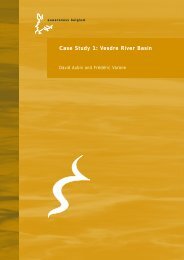Case Study 1: Matarraña River Basin - Euwareness
Case Study 1: Matarraña River Basin - Euwareness
Case Study 1: Matarraña River Basin - Euwareness
You also want an ePaper? Increase the reach of your titles
YUMPU automatically turns print PDFs into web optimized ePapers that Google loves.
asin. This situation seems to result mainly from two types of situations.<br />
On the one hand, some small vegetable crops, mainly located in the higher river basin,<br />
were progressively reconverted into animal farms a couple of decades ago. Nowadays,<br />
around 60% of the total income in the higher basin come from cattle. Cattle demands<br />
much lower quantities of water and is economically more profitable than traditional<br />
agriculture. Some of these users say they applied for a concession to the CHE around<br />
15 years ago, but the CHE is said to have rejected these applications by saying that<br />
water uses have changed. However, the CHE seems to informally accept these uses.<br />
On the other hand, along the seventies the extension of cultivated lands in the<br />
<strong>Matarraña</strong> river basin increased in about 1,000 Has more, partly because the CHE had<br />
built a tunnel to divert water and because of the profits of peach crops (some users had<br />
a concession and some others did not). In spite of that, the CHE did not give<br />
concessions for the irrigation to the whole of the new 1,000 Has, as either the Pena<br />
water dam and the tunnel supposedly covered most of the existing irrigation<br />
necessities. To this respect, the Central Union gave a kind of “permit” to use water to<br />
the irrigation communities with plots having no concession, that is, to illegal users.<br />
According to this, all irrigation communities that have applied for the use of water for<br />
irrigation and cattle but having no concession can take the remaining waters from the<br />
<strong>Matarraña</strong> river from October to March as far as this does not cause trouble to the<br />
irrigation communities having a concession. While the CHE is most likely to be aware<br />
of the existence of illegal users, it leaves water distribution and organisation in the<br />
hands of the Central Union.<br />
In both types of situation, water is used illegally as these users do not have legal<br />
concessions. Illegal uses of water include abusing uses, for instance, the storage of<br />
water in illegal pools, the starting of illegal engines to water lands at night, and so on.<br />
However, beyond those ‘hidden’ uses, users with no concessions are tolerated by their<br />
corresponding irrigation communities as far as they do not damage their interests. This<br />
is shown by the fact that illegal users pay for the use of water to their corresponding<br />
irrigation communities. This is a kind of trade-off for illegal users for being allowed to<br />
irrigate, even though they do so in worse conditions than the users holding a<br />
concession. This means that illegal users have a kind of de facto use right in practice<br />
that to some extent is accepted by all irrigation communities (all irrigation communities<br />
are said to have illegal users).<br />
27



